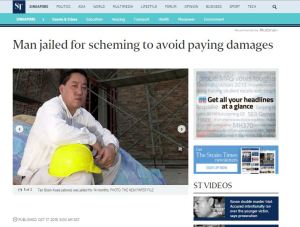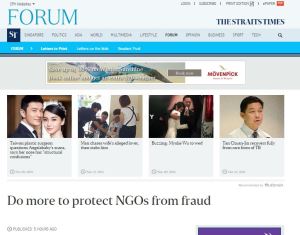Five interesting Indonesian speakers who have been on the ground in the worst hit provinces of Indonesia. The following are my notes and interpretation. The most important message:
LAND USE GOVERNANCE IS THE ONLY TRUE SOLUTION
Lahiru S. Wijedasa, 24 November 2015
https://conservationlinks.wordpress.com/
PDF: 2015 ConservationLinks – Fighting the Haze – Insights from Indonesia’s worst-hit provinces
DATE: 23 November 2015, TIME: 5.30-7.00pm
HOSTED BY: Singapore Institute of International Affairs (SIIA)
OPENING STATEMENTS
| KONI SAMADHI Indonesia country director for World Resources Institute.
Formerly a Deputy Minister in the previous government. He played an important role setting up and running the REDD+ and OneMap initiative. Probably the most important person in forest governance and land use in Indonesia. Profile at WRI: http://www.wri.org/profile/koni-samadhi DISCLAIMER: The text below is based on notes taken during the discussion and are not the exact words of the participant. Land Use Governance is the only true solutionPresident Jokowi is serious about this. However, the current focus is only on the emergency side of things (i.e. the current fire and haze) which is not good. In reality, the real solution is to improve land use governance. We do need more coordinated action to improve governance. Currently in Indonesia, we have a silo kind of governance, where sectors work within their own areas, knowing that this is counterproductive to overall land use management. The previous government did have a national standard with regard to how to prevent and manage forest fires. If this is legalized, we would have a systematic way to deal with land and forest fire issues from the national to sub-sub district level. This standard would allow all levels of government to mobilise resources. Currently governments can only mobilise all parts of government in the case of emergency. If the standard is implemented it would make it easier to mobilise all parts of government even in non-emergency cases and deal with the fires.
|
| FERI IRAWAN An activist with Sawit Watch – http://sawitwatch.or.id/
He has been active in the Jambi province, on the ground finding hotspots, causes and culprits. Handing over vital information to the government who have taken over the role of investigation and prosecution. DISCLAIMER: The text below is based on notes taken during the discussion and are not the exact words of the participant. Feri Irawan spoke in Bhasa Indonesia with a translator from P.M. Haze. PrioritiesThe first priority is to pressure the government to deal with fires. Second is to penalize those at fault. InvestigationsHe has carried out investigative work to identify fire hotspots, Most of these areas have peat depths greater than 7-12m. Up to 80% of the companies identified produce palm oil, of which many comes to other countries including Singapore. With his data and investigations he has identified companies which he has brought to court. Four companies awaiting trial – two palm oil and two industrial forests. The government appears to be stricter this time around compared to last time. He has worked extensively with local people and found that they had not been planting oil palm until companies came. Health Issues in JambiThe main pressure he can bring on the government is with regards to health. Two infants have dies, 200 more are affected and many pregnant women are affected. He is pushing the government to provide free healthcare. Future WorkWork with both locals and companies to improve their fire protective measures.
|
| MATURIDI – Journalist working for Kalteng Pos. He lives in Palangkaraya, Central Kalimantan, which has seen of the worst haze levels.
His Twitter account: https://twitter.com/elmatur DISCLAIMER: The text below is based on notes taken during the discussion and are not the exact words of the participant. Maturidi spoke in Bhasa Indonesia with a translator from P.M. Haze. The need for fire for land clearance by indigenous DayaksThe haze started after drainage for the Megarice project, there have been annual fires but this year has been the worst. The Dayak people are suffering the brunt. Over the past 17 years the Dayak people have been protesting. Despite the fact that the Dayaks are suffering, they are being blamed by the government. Slash and burn techniques of Dayaks have been banned, but not for the companies. The Dayaks are confused on how to clear forest for the future. This is the sole income source. The recent fires have burnt hundreds of acres of rubber and rattan plantations that belong to people have been burned.
|
QUESTION AND ANSWER SESSION
QUESTION 1: HOW DO YOU PUT OUT A FIRE THAT IS 12M DEEP?
Feri Irawan – Good question. Presently no technology to put out first in Indonesia. So wait for the rain. President has said, no permit will be given to peatlands. Simon Tay – Local people have no way to put out fires. Maturidi – Dayak people create wells in the middle of the forest so they have a source of water to douse the fire with. Simon Tay – No conflict among the Dayaks. |
|||||||||||||||||||
QUESTION 2: CORPORATES OR SMALL HOLDER DAYAKS, WHO IS THE PROBLEM?Maturidi – The companies are given permit by the government. Of which they pay locals to clear the land.
|
|||||||||||||||||||
QUESTION 3: HOW MUCH ARE LOCALS PAID TO CLEAR LAND?
Maturidi – 100$ per ha. Mostly pay you to pay him. No technology to clear properly. Feri Irawan – Jambi is 7USD per day, vs $600 per ha to clear a land properly. The ones he is investigating are most likely to be really set by them. Police has taken over investigations. Agus (CIFOR expert in the audience) – Based on our study, many actors in land clearing. We found that the fire can start from illegal farmers but also from companies. So many motives. Someone gets paid to clear the land. Many actors are individual farmers who have the capacity. Not just companies with large areas of land. Not just 1 – 2ha. Could be individuals with 1000s of hectares. 665$/ha. About 14% ($96) goes to the farmer who does the slashing. About 12% ($80) goes to tree cutting, farmer group activity organise get 50% ($338), also involves village head and officer who get a cut, trying to get land and sell it other party. Summary:
|
|||||||||||||||||||
QUESTION 4: PRESIDENT JOKOWI HAS SAID THAT HE IS NOT AWARDING ANY MORE CONCESSION ON PEATLANDS. HOWEVER, MOST PEATLAND ARE UNDER MORATORIUM WHILE ANOTHER SIGNIFICANT PROPORTION ARE ALREADY UNDER CONCESSIONS. WHAT DOES HE REALLY MEAN? IS HE CONSERVING ANYTHING MORE?Koni Samadhi – President Jokowi. Talked about a ban not a moratorium. That is different from a moratorium with a time limit. The ban is perpetual with no time limit. Peatlands in concessions will be taken back.
|
CONCLUDING COMMENTS FROM SPEAKERS
| Feri Irawan –
Effectiveness in controlling fires is possible. But the focus should be on educating the people to not be perpetrators of fires.
Prayoto – We have used fires for a long time. So why is it different now? It is because drainage for palm oil and Acacia is the problem. We need to develop new agriculture technology for peatlands. Land encroachment is very dangerous, it is the start of the fire. For example in Rokan Hilir district in Riau, illegal encroachment by middle income companies, majority from Medan (i.e. not Riau). Regarding the moratorium, most of Riau is under concessions so the moratorium has no effect.
Maturidi – There is currently no more fire in Kalimantan. Not because it was extinguished by people but because of rain. The locals are trying to do a peatland restoration program. I would like to pass a message to the people of Singapore: The thousands of masks you sent have been given out, we thank you for them.
|


